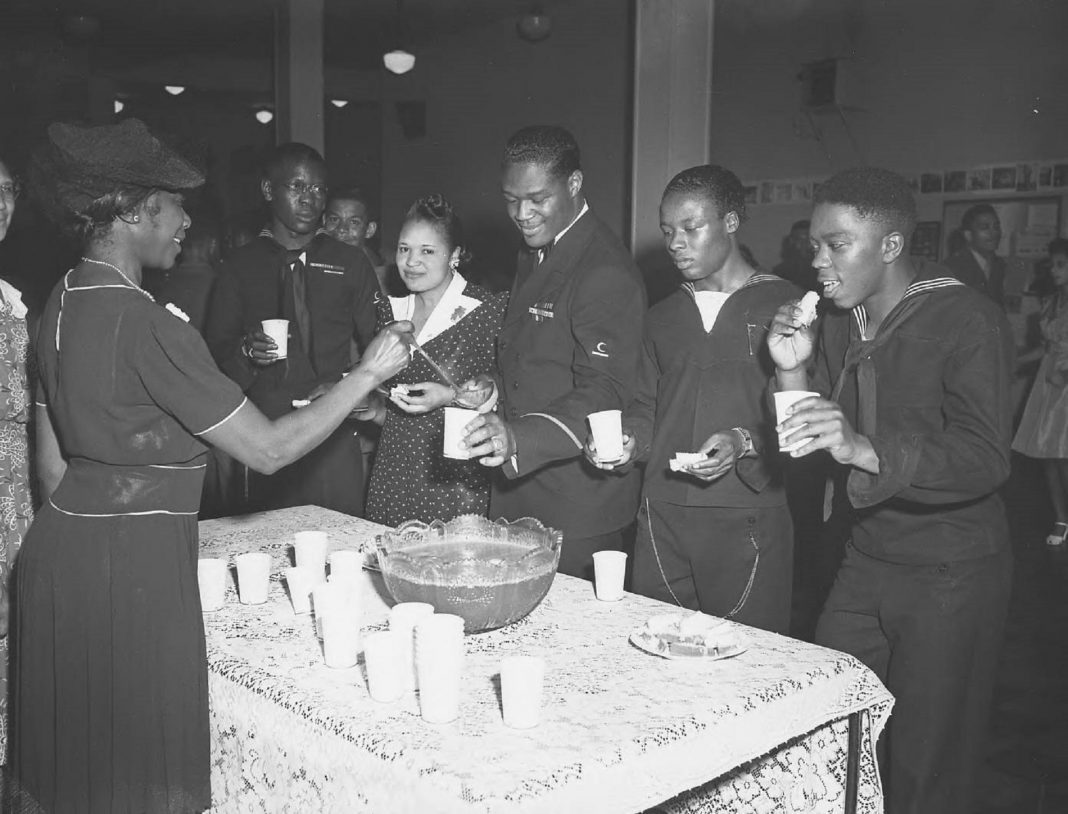In 1942 Tacoma hosted Doris Miller, a Navy hero. This Black sailor’s heroism at Pearl Harbor helped end segregation in the American Navy.

Joining the Navy
Doris “Dorie” Miller was born on October 12, 1919, to Connery and Henrietta Miller, sharecroppers in Waco, Texas. (Doris could be a male name during that time). The third of four sons, he dropped out of high school (where he had played fullback on the football team) to help his struggling family by taking a job in a small restaurant.
In 1939, just shy of his twentieth birthday, Miller enlisted in the Navy. At the time, the Navy was strictly segregated. Black sailors like Miller were relegated to the Messman branch and prohibited from wearing the naval insignia shirt buttons. Despite it all, Miller later said that “it beats sitting around Waco working as a busboy, going nowhere.”
Mess Attendant, Third Class Miller was assigned to the West Virginia battleship. The vessel was soon reassigned with the Pacific Fleet to Pearl Harbor as tensions rose with Japan.

Pearl Harbor
Early in the morning on Sunday, December 7, 1941, the Japanese military launched a surprise attack on Pearl Harbor. When a torpedo struck the ship, Miller was below decks doing an officer’s laundry. His battle station in the magazine (where messmen handed ammunition up to the gunners) was flooded. Ship’s communications officer Lieutenant Commander Dior Johnson, ordered him up to the signals deck. The ship’s boxing heavyweight champion, Miller, carried the ship’s mortally wounded Captain Mervyn Bennion to safety.
By then, the ship was severely damaged and listing heavily, but the guns on their part of the ship were still working. On the burning deck, Miller fed ammunition to Lieutenant (Junior Grade.) Frederic White’s anti-aircraft gun. Spying its twin gun empty and without training, Miller opened fire.
“It wasn’t hard,” he said modestly later. “I just pulled the trigger, and she worked fine.”
“He had a good eye,” White praised him. Johnson described Miller as “blazing away as though he had fired one all his life.” While later stories claimed Miller shot down five or six planes, he likely did not down any.
The ship was beginning to sink. Captain Bennion had died, and Miller had run out of ammunition. The group left the bridge. Miller helped pull sailors from the burning water on the boat deck before the ship was ordered abandoned. He swam 300 to 400 yards through patches of burning oil and strafing fire to shore. “With those bullets spattering all around me,” he later said, “it was by the grace of God that I never got a scratch.” Once ashore, he helped many sailors to safety.
Honoring a Hero
The United States declared war on Japan the next day. It took some time for Miller’s heroism to be noticed, though he was listed anonymously in newspapers and commendations lists. Although a bill to award Miller the Medal of Honor was defeated in Congress, President Roosevelt authorized awarding him the Navy Cross, the second highest naval award for heroism during combat.
Miller was presented the honor by Admiral Chester Nimitz aboard the Enterprise on May 27, 1942. It was the first time a Black man had received the medal. Meanwhile, Miller had been reassigned to the heavy cruiser Indianapolis in the South Pacific.
At the urging of the Black press and other national leaders, Miller was sent on a national war bond drive tour. For several months he toured the country before reporting to the Puget Sound Naval Shipyard in Bremerton. During his time in Washington, he visited Tacoma.

Visiting Tacoma
During the week of July 3, Miller visited USO #2, a Black USO center. Opened in September 1942, it served Black servicemen and women and war workers. Located at 713-15 Commerce Street, the center had many visitors before it closed in 1947.
Miller’s visit, however, was downplayed by local newspapers. “USO Reception honors winner of Navy Cross,” reported the Tacoma News Tribune on July 3, 1943, a few days after his visit. They praised him as “Modest in the extreme and reticent in discussing his experiences…He hails from Waco, Texas,” they continued, “where his parents still live, waiting for that time that victory is won and Dorie and his three brothers return from the armed forces in which they are all serving.”
A dance and party were held in Miller’s honor, where he spoke about war bonds and his actions during Pearl Harbor. The reception committee consisted of Chaplain G. H. Martin, Lieutenant Harold Jones (both of Fort Lewis), Bennie Brown, Roy Vaughan and other USO staff members.
Death of Doris
In August, the newly built escort carrier Liscome Bay in Bremerton was commissioned. Miller was assigned to the ship’s galley and promoted to cook, third class. This ship supported marine landings at Makin and Tarawa.
On November 24, 1943, a single torpedo from a Japanese submarine struck the ship. Moments later, its aircraft magazine exploded. The ship sank in 23 minutes. Of 800 crew members, only 272 survived. Miller was not among them.
Miller’s Legacy
Since his death, roads, elementary schools and other buildings have been named in Miller’s honor. Recently the Doris Miller Memorial was built at Bledsoe-Miller Park in his hometown of Waco. In 1973 the Navy named a destroyer escort ship for him; in 2019, it was announced that an upcoming nuclear-powered aircraft carrier would be named in his honor.
Miller also proved an inspiration for ending segregation in the U.S. Navy. The Navy took tentative steps to end segregation during World War II, opening up programs for special training and officers. In 1946 the Navy officially desegregated. Miller would have been proud.


































